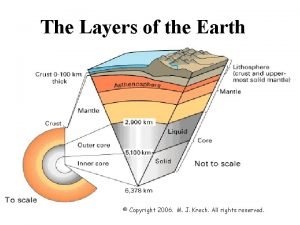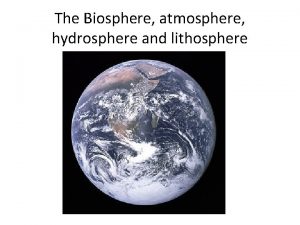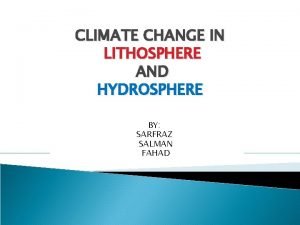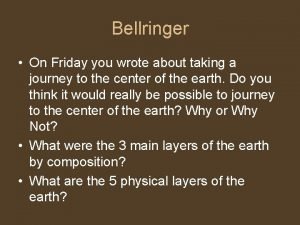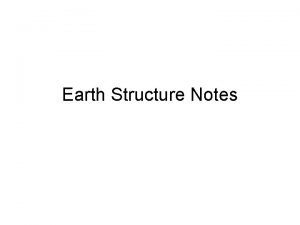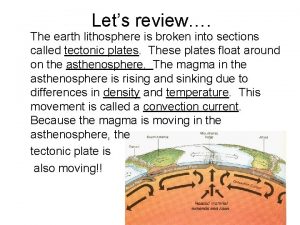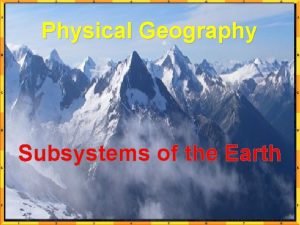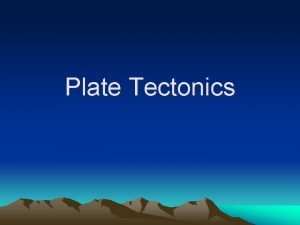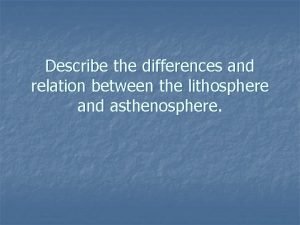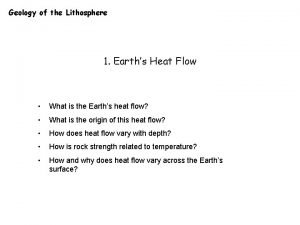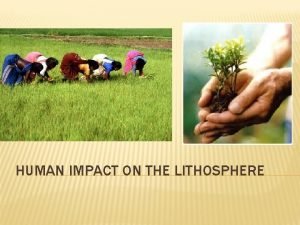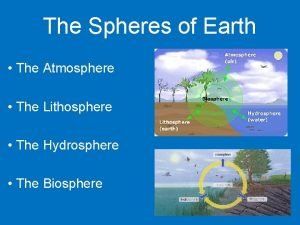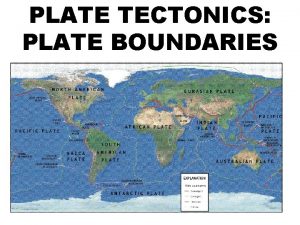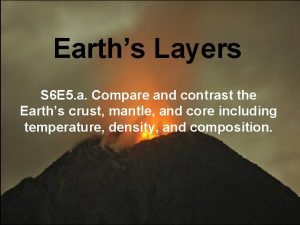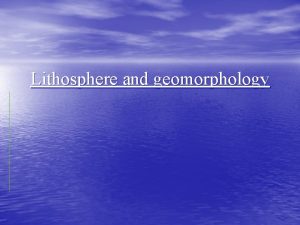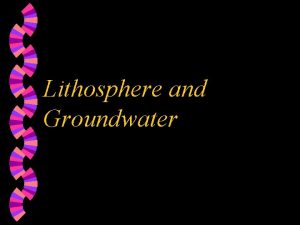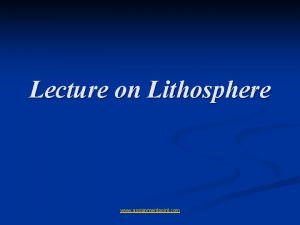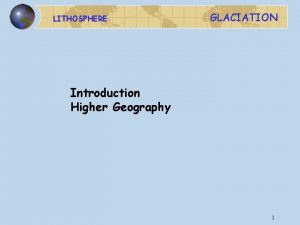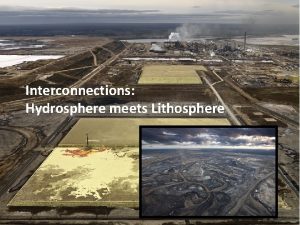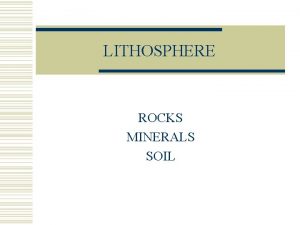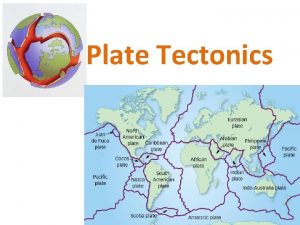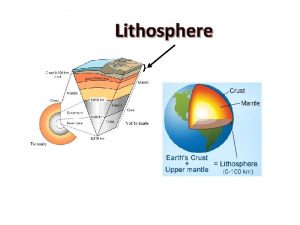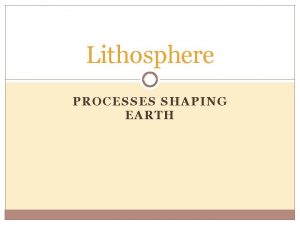The Lithosphere There term lithosphere is in a



























- Slides: 27

The Lithosphere There term lithosphere is in a variety of ways. The most general use is as: The lithosphere is the upper region of the crust and mantle that behaves more or less rigidly, transmitting stress on a global scale. Earth’s tectonic plates are contiguous regions of lithosphere that move relative to each other and deform primarily at their boundaries. Because we don’t have a unified theory for what the lithosphere actually is, it is common to talk about the lithosphere as defined by particularly properties. We thus have: The thermal lithosphere • Earth’s upper thermal boundary layer The mechanical lithosphere • The portion of thermal lithophere that behave elastically The seismic lithosphere, or lid • The high-velociy region overlying the asthernospheric LVZ These are mostly used for oceanic lithosphere. Continental lithosphere is quite different, so Continental lithosphere • Often described as a “chemical boundary layer”

Thermal lithosphere • Earth’s upper thermal boundary layer • temperature-dependent density makes the lithosphere sink • thermal subsidence of oceanic lithosphere with age is the primary constraint on lithospheric thermal structure • heat flow measurements also provide some constraint • the two main models for how temperature evolves with time in the lithosphere are the half-space and plate-cooling models • these models predict both thermal subsidence and heat flow as a function of lithospheric age • the most common explanation for why the plate model seems more appropriate than the half-space cooling is secondary convection


Heat Flow Why we care • Internal heating due to radioactive decay plus cooling due to conductive heat flow drives mantle convection, plate tectonics, and enables life • physical properties of rocks are temperature-dependent, e. g. (T), (T) Quantities • Heat: like the total “vibrational” energy of all elements in a system • Temperature: like the average “vibrational” energy Conductive heat flow • heat “flows” from hot regions to cold regions • rate of heat flow is proportional to thermal gradient


The Heat Equation Specific heat: CP = is the amount of heat necessary to raise 1 kg of material 1°C Using CPV to convert heat to temperature, • Solve this equation with different boundary conditions to predict T(x, t) of the lithosphere • With this solution, knowledge of (T) enables prediction of h(t) = seafloor depth with age



Isostasy • Isostasy is the concept that adjacent "columns" of mass, extending from some reference level at the Earth's surface to some depth of compensation, should be equal. • Isostasy follows from the assumption that Earth’s mantle behaves like a fluid at long time scales, and so the pressure within the fluid must be equal at a given depth.

Predictions of the Half-space cooling model 1 D Solution: Thermal expansion: (T) = (1 - V T) V = volumetric coefficient of thermal expansion T = (T - T 0) Bathymetry:


Plate cooling model, early observations L = 125 ± 10 km TM = 1333°C ± 274°C V = (3. 28 ± 1. 19) x 10 -5 °C-1 L = 128 ± 10 km TM = 1365°C ± 276°C V = (3. 1 ± 1. 11) x 10 -5 °C-1 Parsons and Sclater, 1977

Stein and Stein, 1992

Stein and Stein, 1992

Ritzwoller et al. , 2004



The mechanical lithosphere • The lithosphere is plate like in that it behaves rigidly - there are very few intraplate earthquakes - plates transmit stress; little deformation except at the edges • The lithosphere behaves elastically over geologic timescales, whereas the underlying mantle behaves like a viscous fluid • Temperature and volatiles seem to control the lithosphere’s mechanical properties Two main types of observations are used to infer the mechanical properties of the lithosphere (still just oceanic lithosphere). • The maximum depth of intraplate earthquakes - intraplate earthquakes at inferred temperatures greater than 600°C are rare, and so the region above this isotherm is commonly referred to as the mechanical lithosphere or boundary layer. • “Elastic” plate thickness, as determined from plate flexure in response to discrete loads, provides information on relative mechanical properties, though it’s not clear what this thickness really means.

MBL TBL

Some of these EQs are from near islands and so involve reheated lithosphere and magmatic activity. Some are from transforms and involve serpentinization. The most useful ones are from trenches, and so these may also be serpentinized. This distribution probably can’t be made sense of. The deepest earthquakes probably mark something like a brittle/ductile transition. Weins and Stein, 1983

Elastic plate thickness • The lithosphere is observed to flex under applied loads • This flexure resembles that of a thin elastic plate • Equations exist that relate plate flexure to elastic thickness • When these equations are applied to observed lithospheric flexure, it is hard to make sense of the results


The seismic lid • Seismic velocity is a material physical property • There are two classes of seismic waves, body waves and surface waves • There two types of body wave, compressional and shear waves, which propagate at different speeds: VP = [ (K + 4/3 )/ ]1/2 , VS = ( / )1/2 • Surface waves travel along the surface, and the two most important type of surface waves are Rayleigh and Love waves. Their seismic velocities are complicated. • The best constraints on lithospheric seismic velocity come from surface waves, which provide good constraint on path-averaged absolute velocity as a function of depth.

2007

The seismic lid Three key points 1) The high velocity of the lid can not be explained by temperature alone. This suggests a compositional component to the lithosphere and associated properties. Likely sources of compositional differences wrt the deeper mantle are: - depletion in volatiles - existence of an eclogite phase 2) The LVZ is the primary evidence for a low-viscosity channel, referred to as the asthenosphere. The low velocities are too low to be explained solely by temperature, suggesting the possible presence of melt. 3) There is some suggesting that LID structure does not vary with age, suggesting that lithospheric mechanical properties do not evolve as the lithosphere cools, I. e. that something other than temperature controls mechanical properties.


 Lithosphere
Lithosphere Lithosphere clipart
Lithosphere clipart Hydrosphere lithosphere atmosphere
Hydrosphere lithosphere atmosphere Lithosphere
Lithosphere Lithosphere, asthenosphere, mesosphere
Lithosphere, asthenosphere, mesosphere Layers of the earth convection currents
Layers of the earth convection currents The lithosphere is broken into
The lithosphere is broken into Lithosphere ecosystem
Lithosphere ecosystem Lithosphere
Lithosphere The lithosphere is divided into
The lithosphere is divided into Lithosphere and asthenosphere
Lithosphere and asthenosphere Heat-mass transfer and geodynamics of the lithosphere:
Heat-mass transfer and geodynamics of the lithosphere: Human impact on lithosphere
Human impact on lithosphere Hydrosphere and cryosphere
Hydrosphere and cryosphere What layers of earth make up the lithosphere
What layers of earth make up the lithosphere Explain the theory of plate tectonics.
Explain the theory of plate tectonics. Earths layers foldable
Earths layers foldable 5 physical layers of the earth
5 physical layers of the earth Minterm maxterm
Minterm maxterm Term-to-term rule
Term-to-term rule Position to term rule worksheet
Position to term rule worksheet Short term financial management
Short term financial management Rules in finding the nth term
Rules in finding the nth term Long term memory vs short term memory
Long term memory vs short term memory Difference between long term and short term liabilities
Difference between long term and short term liabilities Term to term rule
Term to term rule Fraction sequence
Fraction sequence Accounting for serial bonds
Accounting for serial bonds
